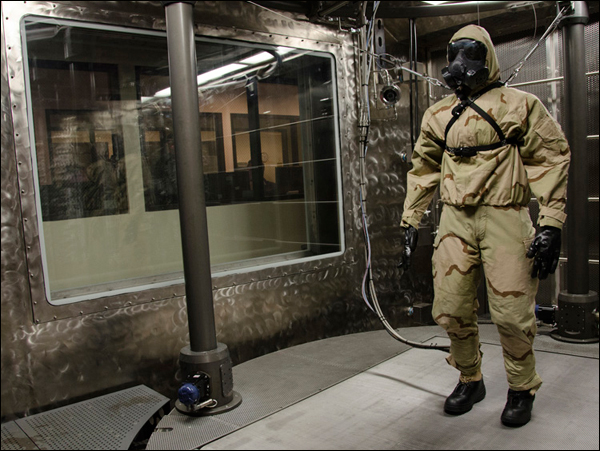
The completion of a human-like robot designed to provide data on the effectiveness of protective military gear against exposure to dangerous chemicals is a source of pride to one Vanderbilt School of Engineering graduate who was part of the development team.
Joe Clement (BE’97, mechanical engineering and mathematics), a senior engineer with Kansas City-based MRIGlobal, was a member on the five-year Individual Protection Ensemble Mannequin System (IPEMS) project, which amassed a team of experts from across the country. MRIGlobal installed IPEMS, which combines the advanced robotic mannequin and an environmentally controlled containment chamber in order to test protective military clothing for the U.S. Department of Defense.
When the project is complete, the military will be able to test a Soldier’s Individual Protective Equipment (IPE) on the robotic mannequin using a full range of motion, while exposed to various chemical warfare agents.

Clement, who’s been fascinated with robotics for years, said the movements are incredibly lifelike. The robotic mannequin is of average height and anthropomorphic dimensions, but it sports a surface system that warms to body temperature and sweats, and also incorporates sophisticated sensors to provide near real-time indication of chemical intrusion into the IPE.
“From a mechanics and a control standpoint, it represents the highest level of robotics I’ve seen,” Clement said. “For a project of this magnitude, there’s been a lot of ‘never befores’ in this one.”
MRIGlobal reports that humans are currently still used to test protective gear, using non-toxic chemicals that mimic chemical warfare agents. IPEMS would remove humans from the equation and allow for fully reproducible tests of chemical warfare agents, with near real-time feedback. The tests will occur in a variety of environmental conditions and be fully reproducible.
The Individual Protection Ensemble Mannequin System now resides at the Army’s Dugway Proving Ground, Utah.
Clement stressed the importance of developing a free-standing, humanoid robot over ‘dummy-like’ mannequins, because any rods, bars or cables used to suspend and animate them need to be attached to the mannequin itself. That, he said, would result in openings (mostly open seams) in the protective gear and potential leaks would affect data gathering.
“There were many challenging aspects to this project,” said Clement, adding that he is satisfied with the results. “And the potential ‘life saving’ component added a lot to it.”
Clement said continual communication was the key to keeping the team on task and on track to complete the project on time. He remarked that there were so many tasks (tied to sensors or air flow or decontaminants, etc.) he himself had several that varied through the course of the project.
“We had significant requirements,” he said. “Communication was the key. We constantly were asking ‘what can we do,’ ‘what can’t we do’?”
The concept of simulating realistic soldier movements began with Boston Dynamics, one of five subcontractors working with MRIGlobal on the IPEMS project.
MRIGlobal, an independent nonprofit that conducts programs in the areas of national security and defense, life sciences, energy and the environment, agriculture and food safety, and engineering and infrastructure, orchestrated this five-year program while directing the subcontractors to develop and integrate the mannequin, its sensors, and its high containment facility.
Clement can thank Vanderbilt University for helping him find his way to MRIGlobal, though not in the manner you might expect. It was on West End that Clement found his future wife, who had family in Kansas City and wanted to practice law there. After finishing his master’s degree and doctorate work at University of Michigan, he landed at MRIGlobal.
“I thought I would be working in the automotive or aerospace industries, but I love working at MRIGlobal,” he said. “For as long as I can remember, I have always been interested in how things work. With IPEMS, we had the best advanced robotics minds in the industry. I was proud to be part of the team.”